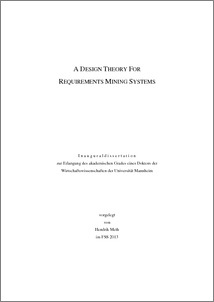|
A design theory for requirements mining systems
Meth, Hendrik
![[img]](https://madoc.bib.uni-mannheim.de/style/images/fileicons/application_pdf.png)  Vorschau |
|
PDF
DIS_Meth_Pflichtexemplare_Online.pdf
- Veröffentlichte Version
Download (2MB)
|
|
URL:
|
https://madoc.bib.uni-mannheim.de/33327
|
|
URN:
|
urn:nbn:de:bsz:180-madoc-333279
|
|
Dokumenttyp:
|
Dissertation
|
|
Erscheinungsjahr:
|
2013
|
|
Ort der Veröffentlichung:
|
Mannheim
|
|
Hochschule:
|
Universität Mannheim
|
|
Gutachter:
|
Mädche, Alexander
|
|
Datum der mündl. Prüfung:
|
10 Juni 2013
|
|
Sprache der Veröffentlichung:
|
Englisch
|
|
Einrichtung:
|
Fakultät für Betriebswirtschaftslehre > Wirtschaftsinformatik IV (Mädche 2009-2015)
|
|
Fachgebiet:
|
004 Informatik
|
|
Normierte Schlagwörter (SWD):
|
Softwareentwicklung , Experiment , Mining , Anforderung , Simulation
|
|
Freie Schlagwörter (Englisch):
|
Requirements engineering , design science , text mining , information retrieval, Natural Language Processing , decision theory
|
|
Abstract:
|
Software requirements are often communicated in unstructured text documents, which need to be analyzed in order to identify and classify individual needs. This process is referred to as requirements mining in the context of this thesis. It is known to be time-consuming and error-prone when performed manually by a requirements engineer. Thus, there is a demand to support requirements mining through information technology. However, little research has been conducted to conceptualize theoretically grounded requirements mining systems and abstract the necessary design knowledge in a theory. Furthermore, existing works scarcely investigate the effect of these artifacts on requirements engineers’ productivity. Consequently in this thesis, the following research question is addressed: How can a system be designed which aims at improving requirements mining productivity over manual discovery?
Following a Design Science approach, a design theory is derived consisting of design requirements, design principles and design features. Design requirements are identified based on general knowledge and kernel theories. Subsequently they are related to design principles which are finally mapped to design features of an artifact.
The artifact is conceptualized in two design cycles, each resulting in a distinct artifact version and its evaluation. In the first design cycle a simulation is conducted to investigate the interplay of the preliminary design principles. In the second design cycle, the effects of the final design principles on requirements mining productivity are measured in an experiment.
The thesis contributes to the design theory body of knowledge by providing a design theory for requirements mining systems. The theory is a contribution to the information systems literature because requirements mining systems represent an important class of design situations that have not been adequately described yet by existing works. From a practical point of view, the study addresses the need of requirements engineers to support their work by information technology and provides vendors of requirements engineering software packages guidelines to improve their products.
|
 | Dieser Eintrag ist Teil der Universitätsbibliographie. |
 | Das Dokument wird vom Publikationsserver der Universitätsbibliothek Mannheim bereitgestellt. |
 Suche Autoren in Suche Autoren in
Sie haben einen Fehler gefunden? Teilen Sie uns Ihren Korrekturwunsch bitte hier mit: E-Mail
Actions (login required)
 |
Eintrag anzeigen |
|
|
